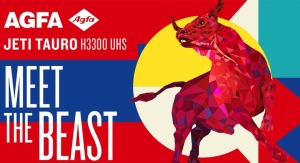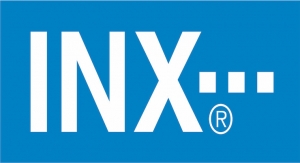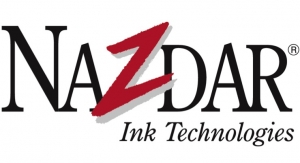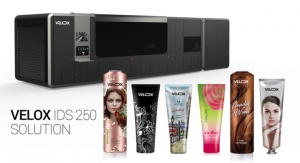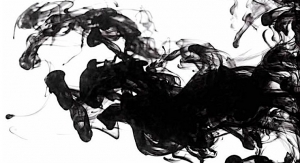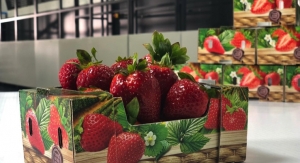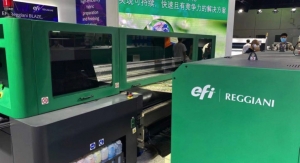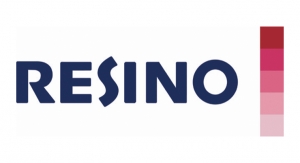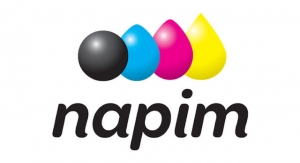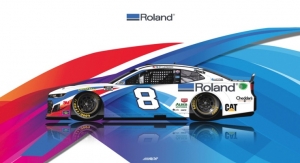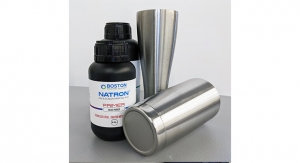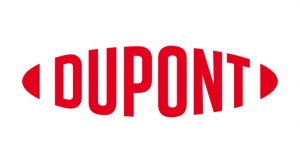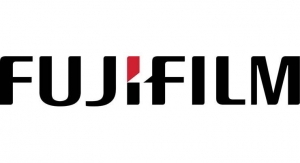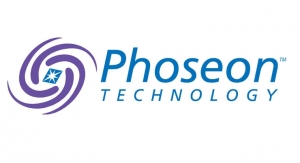David Savastano, Editor10.25.17
The Inkjet Conference (TheIJC), which was held Oct. 23-24, 2017 in Dusseldorf, Germany, featured a record number of presenters, exhibitors and attendees. For the first time, TheIJC featufred a Plenary session as well as three concurrent tracks, TheIJC covers a range of topics, including equipment, printheads, software and inks, for traditional and emerging markets, including textiles, pharmaceuticals and printed electronics. Peter Buttiens, CEO of ESMA, which co-organizes the show with co-founder Steve Knight, said that the growth of this year's TheIJC shows the bright future for inkjet printing.
“TheIJC has been an enormous success. In four years, we have almost doubled the number of presentations and more than doubled the number of tabletops, with 36 new tabletops this year,” said Buttiens. “In addition, 74 new companies sent delegates this year, with 195 new attendees.
“The number of exhibitors and delegates bring together so many possibilities,” added Buttiens. “The level of presentations was exceptional. We have been reinventing TheIJC every year. We went to the Plenary sessions and three tracks this year. We don’t want repetition from year to year. We have 40% new exhibitors, and they bring new subjects. We have 60% more delegates. It is the platform for inkjet.”
“The people who joined us here really make the event very enjoyable to see companies and the exchange of ideas going on,” noted Knight. “The people in this industry are making this possible. We can see the effort that went into the presentations. This is the biggest inkjet technical event in the world. People who are here are building the future.”
Exhibitors agreed that TheIJC Conference continues to grow in influence. Sun Chemical has been attending since the conference began in 2014, and Peter Saunders, global business director Digital for Sun Chemical, said the growth is noticeable.
“It is a heck of a lot larger than it originally was,” said Saunders. “This year feels a lot bigger. There’s a lot of new faces here. For us, it is most important that the OEM equipment and printhead manufacturers are here, as these relationships are critical.”
“It is amazing how this conference has developed since 2014. It has grown by three to four times with more people coming,” added Matthew Schieber, product manager, solvent- and water-based inks for Marabu. “We have many of our R&D people here. We see collaboration partners here and are working on projects with people we have met at previous shows. This show is increasing in value.”
The Inkjet Conference began on Oct. 23, the day before the main event, with three half-day workshops:
• Introduction to Inkjet: Johannes Renner (iPrint) and Steve Knight (TheIJC).
• The Innovation Menu: Eddy Hagen (insights4print).
• Digital Textile Printing: Facing the Reality - Prof. Marc van Parys (TexZeppelin), Thomas Poetz (3T) and Jan Baden (druckprozess).
The new ESMA Expert Café, an open forum format for all conference attendees who want to know how to get the most out of their TheIJC experience, was also offered.
Day 1 Highlights
Kodak’s Dan Denovsky opened the Plenary session with his talk on “Expanding the Boundaries with Continuous Inkjet.” He began with a brief history lesson on digital printing technologies, and Kodak’s focus on water-based pigment inks, which can print on almost any surface.
“Digital printing has been a complement and replacement for offset for 50 years,” Denovsky said. “Mainstream technology has to replace the incumbent technology. It has to have image quality, productivity and cost to replace the incumbent technology.
“Our first generation of digital printing was continuous ink jet, which was founded when we were a division of Mead,” Denovsky continued. “The division was sold to Kodak, which formed Diconix. That, in turn, was sold to Scitex, and then was reacquired by Kodak in 2004. The second generation was Versamark. The third generation was Stream, which debuted at drupa 2008. Ultrastream debuted at drupa 2016, and prints 4 picoliter drops, 600 to 1800 dpi resolution and 500 feet per minute. With Ultrastream, we now have sheetfed offset class quality.”
Kyocera’s Shin Ishikura spoke next with “Advanced Bulk Piezo Ceramics Technology for High Performance Industrial Inkjet Printhead.” Ishikura noted that Kyocera is a piezo inkjet printhead vendor that specializes in piezo electric actuators.
“Our uniqueness owes to the Piezo Ceramic Sheet, which is a fired thin ceramic sheet including numbers of piezo actuators in plane,” said Ishikura. “We have made improvements in material performance and future evolution is ongoing.”
Shane O’Neill of Fujifilm Dimatix then discussed “Advances in Nozzle Architecture Design, Driven by Silicon MEMS Capabilities and Freedoms, to Deliver Next Generation Inkjet Printheads.” He discussed how changing MEMS manufacturing has allowed Dimatix to improve their printheads over the years, resulting in the new GMA printhead.
“Our new GMA puts down more ink per nozzle, but it is not a replacement for Samba printheads,” O’Neill said. “Our new Spider Jet has the same planar shape but the electrode is much larger.”
HP’s Craig Olbrich followed with his talk on “Thermal Inkjet Printhead Technology for Industrial Print.” Olbrich noted that thermal inkjet has been a staple of consumer and office printing for three decades, and HP is using its scalable printhead technology to grow into industrial applications.
“HP dye-based inks have excellent color that is good for home printing, while our pigmented inks are ideal for color office printing,” Olbrich said. “Latex is good for signage, and is environmentally friendly, and solvent-based inkjet inks are designed for packaging.”
One area where HP has evolved is the number of nozzles in its printheads.
“We have been focused on adding nozzles to our printheads over the years,” he observed. “In 1984, our ThnkJet had 12 nozzles. Today, our new PageWide Pro X B/A3 has 56,000 nozzles. For 30 years, the performance of our HP thermal inkjet printheads has doubled every 18 months.”
After the Plenary Session, TheIJC broke off into three concurrent tracks. Track 1 began with Inca Digital’s Dr. Nick Campbell, who focused on “Achieving Industrial Reliability with Inkjet Printing.” Dr. Veena Sarojiniamma of Industrial Inkjet then discussed “Inkjet for High Speed Wallpaper Applications.” Dr. Sarojiniamma noted that new developments in single-pass digital printing have opened up opportunities for interior designs.
“Digital printing is a small portion of the wallcovering market, but wallcoverings are growing in popularity,” Dr. Sarojiniamma said. “Digital can be customized and offers short runs, and producers are looking for something new. The wallpapering market requirements are extreme. It requires high jetting reliability, low gloss, good wash/scrub resistance, meet regulatory standards and be low cost. Still, there is a real demand for digital.”
Mathias Theiler of Hapa covered “How to Integrate UV LED Curing Units in Printing Machines for Perfect Polymerisation.” Dr. Stéphane Biry of BASF gave a talk on “Pigments for Inkjet Food Packaging Printing.”
“Digital printing can compete in any packaging application type,” said Dr. Biry. “The packaging market is $500 billion. Food packaging is 50% of the global consumer packaging market, and 75% of packaging is printed. Companies should take into account food packaging. The penetration of digital packaging is 5%, with CAGR of 15% through 2020, while digital labels are growing at 13.3% CAGR through 2020.”
Dr. Biry added that packaging inks are a sensitive application and are strongly regulated globally. “All printing inks have potential to migrate,” he added. “Low migratory/non-migratory ink components should be selected whenever possible. The entire package must meet regulatory compliance, not just the ink, and the responsibility lies with the printer and ultimately with the brand owner.”
One concern are primary aromatic amines (PAA), which are additives to some pigments; PAAs can be found in azo pigments – yellow, orange, red and magenta – which make up 50% of organic pigments. “Organic pigments have no or extremely low potential to migrate, but primary aromatic amine impurities in azo pigments could migrate,” said Dr. Biry. “There are pigments that are PAA free, such as isoindoline yellow, DPP and copper pthalocyanine.”
Simon Daplyn of Sensient followed with “Digitising the Printing Process for Flooring, Furnishing and other Functional and Industrial Applications.”
“Every substrate has different nuances,” Daplyn said. “Ink requirements include high printing reliability and consistency, with little downtime and maintenance, and you need performance at production speeds. Printhead and system compatibility is important, as is regulatory. Price is a massive consideration, but quality and reliability should also be a consideration.”
Daplyn gave the example of wood laminates for flooring. “Inkjet is used for its ability to vary its design, from wood or stone graphics,” he said. “This requires high color and thermal stability. The big challenge is the substrate, which is highly porous for resins, as melamine must be impregnated into the surface, as well as controlling metamerism, or how the color looks in different lighting.
“Another industry that is wide open for inkjet is printed circuit board manufacturing, as inkjet is additive,” Daplyn added. “You can eliminate photomasks – more environmentally friendly and simplifies manufacturing. Other uses for inkjet are 3D printing, contact lenses, deposit resins for sandpaper, solar, color filters for screens, flexible electronics and OLED displays. Digtial print is ideal in a materials deposition tool within a manufacturing process.”
Brad Riley of Lubrizol then discussed “Ink Receptive Technologies: The Bedrock for Consistent Durability in Industrial Inkjet Systems.” Riley covered case studies in industrial label and textile applications. “There is a trade-off with any pretreatment,” Riley said.
“Inkjet Inks for Packaging: Opportunities and Challenges,” presented by Thorsten Schierle of Evonik, looked at how inkjet printing is helping to meet current packaging needs. Schierle said that challenges for modern food packaging include high performance high regulatory requirements and low migration tendency.
“Companies have to be compliant with latest regulatory demands, and brand owners want to be on the safe side for food packaging,” he added. “Inkjet ink challenges include low viscosity inks to be jetted out of the nozzle, as well as small particle size and narrow particle size distribution to avoid clogging of the small inkjet nozzles.”
Dr. Kai K.O. Bär of Adphos presented a talk on “Instantaneous and Low Thermal Stress Inkjet Post-Processing.” Dr. Bastian Arlt of Anton Paar focused on “Size, Stability and Rheological Analysis of Dispersed Particles.” Dr. Nikolaus Tichawa of Tichawa Vision closed Track 1 with “Contact Image Sensors (CIS) for Digital Print (sheet, r2r, direct-to-shape),” with a look at the different inspection requirements for sheet, roll-to-roll and direct-to-shape digital printing.
Track 2 opened with “Drivers and Requirements for Next Generation Digital Textile Inks,” by Dr. Hamid M. Shirazi of Fujifilm Imaging Colorants. Dr. Shirazi noted that in the 1850s, Sir William Perkin developed the first dye, which led to his further discoveries in organic chemistry. By 1900, more than 2,000 colorants were developed.
Dr. Shirazi then discussed the different types of textile inks, and the differences between dyes and pigments.
“A dye is a single molecule, and pigments are particles, which are more lightfast,” he noted. “Textile ink usage depends upon the fabric. For cellulosic inks like cotton or linen, reactive dyes are used. Acid dyes are used for polyamide fabrics like nylon or silk. Direct dyes are ideal for leather or paper. Dispense dyes are for polyester, and pigments for multi-fiber applications. Pigmented inkjet inks are very good for lightfastness, which is useful for outdoor applications and fabrics.”
Dr. Shirazi then discussed the advantages of inkjet printing of textiles.
“Digital printing for textiles are ideal for sampling and proofing, short runs, inventory management, fast fashion and fashion cycles, personalization and customization and ecommerce,” he observed. “Analog is not agile or flexible. If a rotary screen printer has 10,000 designs, they have to keep 40,000 screens in stock. Meanwhile, e-commerce requires that customer receives their order within 48 to 72 hours of ordering.”
Thomas Hielscher of Hielscher Ultrasonics discussed “Ultrasonic Production of Nano-Size Dispersions and Emulsions,” and Margret Böck of Particle Metrix analyzed “Inline Particle Size Measurement with 180° DLS.”
Debbie Thorp of Global Inkjet Systems analyzed “Image Enhancement Techniques” Florian Fässler of Wifag-Polytype covered “Printing 4.0: What is the Impact of the Fourth Industrial Revolution on Digital Printing?” Meteor Inkjet’s Fernando Rodriguez then offered his insights into “From Printing Models to Practical Solutions: Understanding Printing Speed Constraints and Improving Image Quality in Real Scanning Printers.”
Klaus Ruhmer of Meyer Burger discussed “Semiconductor Packaging is Changing Due to Inkjet Technology,” which discussed why inkjet printing is being adopted by some of the largest global semiconductor producers.
ChemStream’s Els Mannekens analyzed “The Use of Hansen Solubility Parameters (HSP) in the Development of Inkjet Inks.” “Novel System Design for UV Curing of Width from 3” to 90” was presented by Alexander Link of Heraeus Noblelight. Raphael Schoen of Dantec Dynamics followed with “High-Speed inkjet Printing Process Monitoring” for new applications such as printed electronics, sensors and OLED displays.
Track 3 opened with a talk by Dr. Martin Grüßer of Dataphysics, who covered “Multi-Purpose Picodrop Dosing System for Fast and Easy Testing of Ink-Substrate Interactions and Printing Behavior.” Prof. Fritz Bircher and Lionel Buzzetti of iPrint followed with “3D Jet Straightness Analysis by Image Analysis in Different Focal Planes.” Thomas Franz of Baumer Inspection closed the morning portion of Track 3 with “Automatic Optical Inspection in Operation in a 2.250mm Wide Single Pass Printing Line.”
After lunch, Dr. Ronan Daly of University of Cambridge analyzed “Controlling the Destructive Forces Experienced by Functional Materials During Inkjet Printing.” Prof. Simon Gaisford of University College London followed with “Inkjet Printing for Control of Pharmaceutical Polymorphism,” and the interest in using inkjet printing to isolate metastable forms of a number of pharmaceuticals. Dr. Philip Bentley of Tonejet then focused on “Electrostatic Printing for Industrial Packaging: New Developments in Direct-to-Shape Beverage Can Printing.”
“Prevention of Inkjet Nozzle Clogging” was the topic for Dr. Larry Unger of Soliton/PSS. Dr. Kerstin Gläser of Hahn-Schickard Society discussed “Inkjet and Aerosol Jet in the Field of Microtechnology.”
““Printed sensors include temperature sensors, strain sensors, intrusion sensors, magnetic field, gas and touch sensors,” Dr. Glaser said. “Inkjet can be used to print these sensors. I think inkjet has a chance in printed electronics but there are some challenges.”
Prof. Marc van Parys of TexZeppelin covered “Making Digital Technologies Accessible for Textile SMEs.”
Enrico Sowade of Chemnitz University of Technology closed Track 3 with “Inkjet Printing Technology for Printing Functional Layers.” Sowade showed a range of inkjet-printed electronic devices, including resistors, capacitors, diodes, antennas and thin-film transistors, printed sieves for filter applications, printed self-assembled monolayers and others.
“We are using piezo inkjet technology for doing functional printing because we need high flexibility,” Sowade said. “We have sheetfed and web-fed printing capabilities. For printed resistors, we use silver nanoparticle inks and Fujifilm Dimatix printheads to print thousands of printed resistors with yield of close to 100%. We have determined that yield decreases with resistor length. We sinter the nanoparticles to create the dry electrical conductive layer. We also printed several hundred antennas and coils, as well as capacitors.”
Sowade reported that inkjet printing has potential in the printed electronics market. “Inkjet printing is a fully additive process where the ink is deposited only at positions where it is required,” he added. “It is a flexible and reliable technology.”
Day 2 Highlights
The Oct. 25 Plenary Session opened with Dr. Dan Mace of Archipelago Technology, who discussed “Widening the Window: Powerdrop’s Approach to Opening Up Inkjet.”
Dr. Mace noted that people are jetting a wide range of materials, including inks, paint, primers, adhesives, food and biomaterials. The Powerdrop print drum can jet viscous materials such as UV varnish, corrosive pre-coats and hot melt adhesives.
“These materials can be viscous, corrosive, abrasive and require elevated temperature, but many of these materials complement inkjet, like primers and overprint varnishes,” he added. “We are working on primers for cartonboard and flexibles, overprint varnishes for protecting packaging and products and glaze for tiles, and creating new products like adhesives for packaging and manufacturing products, and paint for decorations and coatings.”
Yoshinori Domae of Seiko Instruments then covered “Open the Window Wider with RC1536-L,” Seiko’s follow-up to its successful RC1536 printhead system.
Domae reported that the RC1536 printhead proved to be ideal for ceramic tile and corrugated cardboard applications, but additional adaptations were needed.
“Further requirements we worked on for ceramic tile applications were effect and glaze, with more ink laydown and larger pigments,” he said. “For corrugated, customers wanted white ink and varnish, which needs a combination of small drops and large ink laydown in high speed production.”
“Thanks to the success of RC1536, especially in the ceramic tile industry, we are receiving more demands for many different industrial applications,” Domae added. “We recently developed our new printhead RC1536-L, which provides a wider variety of drop sizes, higher ink laydown and vertical jetting.”
Angus Condie of Xaar closed the second day’s Plenary Session with his talk on “New Print Mode Developments for High Productivity and Laydown Using Xaar Printheads.” Condie noted that high laydown technology is needed for textured special effects for tiles, textured embellishments for labels, Braille printing and “warning triangle” and 3D and advanced manufacturing.
“High Laydown Technology has been achieved with the development of several ‘Single Cycle’ print modes, where all channels can be printed all of the time,” he said. “By contrast, Shared Wall Printing’s nozzles only print one-third of the time.”
The second day then broke into three tracks. Lake Image Systems’ Pete Sirett opened Track 1 with “An Introduction to High Speed Inkjet Print Inspection and Verification,” and how inspection technology needs to evolve for digital printing in the packaging, label and commercial printing markets.
Martin Bailey of Global Graphics Software analyzed “Avoiding the Orange Peel,” and Rob Day of TTP followed with “Digital Coatings: Markets and Technologies.” Day discussed digital decoration and marking technologies, including drop on demand inkjet, continuous inkjet and valve jet.
Dr. Marc Graindourze of AGFA discussed “Industrial Inkjet Printing Solutions from the Perspective of the Ink Design.” He noted that Agfa’s UV inks are used in decoration, product printing, packaging, marking and coding and variable data documents and labels, and offered three examples of inkjet printing.
“Decoration of laminates allows personalization with a UV ink on top of the laminate with a varnish on top for protection,” said Dr. Graindourze. “It also allows production of new designs, short runs and variable runs. It is replacing gravure printing, as inkjet offers short runs using water-based inks.”
Packaging is another important market for inkjet.
Packaging, including labels, direct-to-shaped packaging such as tubes and boxes, migration-sensitive packaging and pharma packaging, are important markets for AGFA’s UV inks.
“You have to select the ink by application, substrate and process,” said Dr. Graindourze. “example, last stage printing of a box allows you to print exact amounts with variable box sizes and image changes. Ink is a key element to the print solution.”
“UV inkjet is a proven technology – it is extremely reliable, and we are over 200 meters a minute today,” he added. “I’m a strong believer in UV. UV inks can fit to a large variety of applications.”
NTS Group’s Dr. Shahzad Khan analyzed “Contactless Cleaning of Printhead.” “The Triple Challenge: Inkjet, Pigment and Textiles” was the topic for Helmuth Haas of CHT R. Beitlich, who looked at inkjet’s impact on the trillion-dollar textile industry, and how textile substrates affect the choice of inks. Pall’s Michael Mehler followed with “Filtration, Degassing and Oxygen Measurement Technologies for Inkjet Printing Applications.”
Dr. Alexander Wannenwetsch of UMS discussed “Advantage of DO-Measurement in the Lab and Online on Board of the Printer.” Frank de Jonge of Armor Industrial Inks concluded Track 1 with his talk on “Inkjet Ink for Printing on Flexible Packaging,” and the challenges of printing aqueous inks for non-porous surfaces. Armor is an industry leader in ink cartridges ad thermal transfer ribbons, and is now branching out into new markets.
“We want new sustainable products,” said de Jonge. “This includes our industrial inks division.”
Flexible packaging is a growing sector. Pira estimates that the flexible food packaging market is $221 billion, and Armor is entering this field.
“Print on demand enables new marketing strategies, including personalization, and has ecological advantages, including reducing stock levels and producing only what you need,” said de Jonge. “One challenge is that we want to print with water and plastic doesn’t print well with water, but only water-based inks can reach all of the requirements of regulatory institutions.”
“The drivers for packaging printers to go digital are short production runs with no set-up cost, personalized printing for individuals, mass customization as a short-term target,” he added. “However, cost and speed are a barrier to go to real digital production Only water-based inks can meet the regulatory requirements.”
Track 2 began with Gerrit Andre of ColorGATE, who discussed “Brand Colour Communication in Digital Printing Workflows,” which is critical for packaging for brand owners. Andre was followed by Dr. Thomas Willers of Krüss, who focused on “Recent Experimental Advances in Characterising Inks and Substrates Optimising Inkjet Processes and Ink Adhesion.” Ralf Martin Eckert of Lambda Technology gave his talk on “NIR Drying in High-Performance Inkjet Printing,” a look at the relationship between substrate, ink and time.
After lunch, Track 2 resumed with “LED-Boosters and Waterborne UV Resins: Solutions for Next Generation Inkjet Inks,” presented by Dr. Kevin Poelmans of Allnex. Integration Technology’s Achim Herzog followed with “The Evolution of UV-LED Curing: Where Next?” Julien Bussi of Caldera covered “How Big Data May Be Applied to Digital Print Industry.”
David Ridealgh of Amazon Filters analyzed “Optimising the Manufacturing Process of Bulk Digital Ink,” and 3M’s Norbert Selzer closed Track 2 with “Reducing Bubble Formation in Inks: Membrane Contactor Design and Process Considerations.”
Track 3 began with a talk by Dr. Michael Korger and Joachim Rees of University of Applied Sciences Niederrhein titled “Eco-Friendly Roll-to-Roll Solution for Digital Pigment Printing on Textiles.” Rees talked about testing done on cotton fabrics.
“We printed mainly on cotton textiles, using a d.gen printer and eight-color d.gen PG-5KR pigment inks,” said Rees. “The tests showed good color strength and fastness. The use of pigment inks and eco-efficient carbon calendar in digital textual printing is reliable and proved.”
Phoseon’s Dirk Exner followed with “Understanding UV Output,” and Dirk Best of ImageXpert closed Track 3’s early portion with “Inkjet Ink Characterisation.”
Kuei’s Giorgio Macor began Track 3’s afternoon session with his talk on “Inkjet Texturing for Effective Surface Embossing,” a look at how 3D texturing brings materials like inkjetted wood and stone to life. Daisuke Hamada of Kao Collins discussed “Advances in Water-Based Ink Solutions,” an important topic as companies look to move away from solvent-based solutions.
“The weakness of water-based inkjet ink is drying performance on non-absorbent substrates like films compared to other inkjet ink solutions such as energy curing and solvents,” said Hamada. “To avoid color mixing is the biggest challenge for water-based inks as there is no penetration of the ink into the substrate. You need stable jetting even at high concentrated of pigment as well as small droplets.”
Hamada said that pigment dispersion stability is one key for success. “Kao’s Pigment Nano-Dispersion Technology features encapsulation by a special polymer, he added. “Pigment dispersion stability in the water-based ink was found to be a key for printing on films. Ink formulation could improve the image quality minimizing color mixing.”
“Inkjet Waveform Optimisation by Meniscus Motion Analysis,” covered by Johannes Renner of iPrint, was up next, followed by Matsui’s Jesse Martinez, who covered “Revolution of T-Shirt Printing.” Martinez compared the combination of screen and inkjet printing vs. PVC plastisol printing. He noted that the speed of screen and inkjet printing has increased to 450 shirts per hour.
“Dyestone Color is neither a pigment or dyestuff, but a patented new generation of textile colorants that fully utilize our original micro-encapsulating technology,” said Martinez. “The entire range of Dyestone Color products are considered green, as it offers considerable savings in water and CO2.”
Martinez noted that the new Dyestone DigiAce is designed for piezo printers. “Dyestone DigiAce is a pigmented inkjet ink for piezo type of printers. It can be printed on any textile substrate, and competes with the sublimation process,” Martinez added. “It can be manufactured for almost all inkjet printhead manufacturers.”
Martinez said that combining screen print and DigiAce is ideal for large production.
“Screen printing has its advantages and disadvantages,” he noted. “You are limited to large production runs. But hybrid printing for T-shirts, a white opaque layer is screen printed on a color fabric, with an inkjet color printed over the opaque layer. It doesn’t require many screens or pretreatment. It is good for samples or for multiple different designs in a high production volume.”
Dr. Cristina Rodriguez-Rivero of the University of Cambridge closed Track 3 with “Experimental Set-Up to Investigate Forces and Airflows on Inkjet Droplets.”
Next year, TheIJC will hold its first conference in the US, from April 12-13 at The Westin O'Hare in Chicago, IL. For more information, contact ESMA at info@esma.comor info@theijc.com.
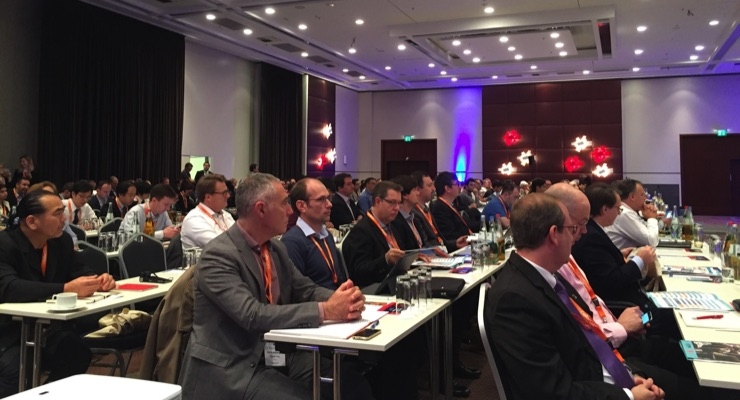
Delegates attend the first Plenary session during TheIJC 2017.
“TheIJC has been an enormous success. In four years, we have almost doubled the number of presentations and more than doubled the number of tabletops, with 36 new tabletops this year,” said Buttiens. “In addition, 74 new companies sent delegates this year, with 195 new attendees.
“The number of exhibitors and delegates bring together so many possibilities,” added Buttiens. “The level of presentations was exceptional. We have been reinventing TheIJC every year. We went to the Plenary sessions and three tracks this year. We don’t want repetition from year to year. We have 40% new exhibitors, and they bring new subjects. We have 60% more delegates. It is the platform for inkjet.”
“The people who joined us here really make the event very enjoyable to see companies and the exchange of ideas going on,” noted Knight. “The people in this industry are making this possible. We can see the effort that went into the presentations. This is the biggest inkjet technical event in the world. People who are here are building the future.”
Exhibitors agreed that TheIJC Conference continues to grow in influence. Sun Chemical has been attending since the conference began in 2014, and Peter Saunders, global business director Digital for Sun Chemical, said the growth is noticeable.
“It is a heck of a lot larger than it originally was,” said Saunders. “This year feels a lot bigger. There’s a lot of new faces here. For us, it is most important that the OEM equipment and printhead manufacturers are here, as these relationships are critical.”
“It is amazing how this conference has developed since 2014. It has grown by three to four times with more people coming,” added Matthew Schieber, product manager, solvent- and water-based inks for Marabu. “We have many of our R&D people here. We see collaboration partners here and are working on projects with people we have met at previous shows. This show is increasing in value.”
The Inkjet Conference began on Oct. 23, the day before the main event, with three half-day workshops:
• Introduction to Inkjet: Johannes Renner (iPrint) and Steve Knight (TheIJC).
• The Innovation Menu: Eddy Hagen (insights4print).
• Digital Textile Printing: Facing the Reality - Prof. Marc van Parys (TexZeppelin), Thomas Poetz (3T) and Jan Baden (druckprozess).
The new ESMA Expert Café, an open forum format for all conference attendees who want to know how to get the most out of their TheIJC experience, was also offered.
Day 1 Highlights
Kodak’s Dan Denovsky opened the Plenary session with his talk on “Expanding the Boundaries with Continuous Inkjet.” He began with a brief history lesson on digital printing technologies, and Kodak’s focus on water-based pigment inks, which can print on almost any surface.
“Digital printing has been a complement and replacement for offset for 50 years,” Denovsky said. “Mainstream technology has to replace the incumbent technology. It has to have image quality, productivity and cost to replace the incumbent technology.
“Our first generation of digital printing was continuous ink jet, which was founded when we were a division of Mead,” Denovsky continued. “The division was sold to Kodak, which formed Diconix. That, in turn, was sold to Scitex, and then was reacquired by Kodak in 2004. The second generation was Versamark. The third generation was Stream, which debuted at drupa 2008. Ultrastream debuted at drupa 2016, and prints 4 picoliter drops, 600 to 1800 dpi resolution and 500 feet per minute. With Ultrastream, we now have sheetfed offset class quality.”
Kyocera’s Shin Ishikura spoke next with “Advanced Bulk Piezo Ceramics Technology for High Performance Industrial Inkjet Printhead.” Ishikura noted that Kyocera is a piezo inkjet printhead vendor that specializes in piezo electric actuators.
“Our uniqueness owes to the Piezo Ceramic Sheet, which is a fired thin ceramic sheet including numbers of piezo actuators in plane,” said Ishikura. “We have made improvements in material performance and future evolution is ongoing.”
Shane O’Neill of Fujifilm Dimatix then discussed “Advances in Nozzle Architecture Design, Driven by Silicon MEMS Capabilities and Freedoms, to Deliver Next Generation Inkjet Printheads.” He discussed how changing MEMS manufacturing has allowed Dimatix to improve their printheads over the years, resulting in the new GMA printhead.
“Our new GMA puts down more ink per nozzle, but it is not a replacement for Samba printheads,” O’Neill said. “Our new Spider Jet has the same planar shape but the electrode is much larger.”
HP’s Craig Olbrich followed with his talk on “Thermal Inkjet Printhead Technology for Industrial Print.” Olbrich noted that thermal inkjet has been a staple of consumer and office printing for three decades, and HP is using its scalable printhead technology to grow into industrial applications.
“HP dye-based inks have excellent color that is good for home printing, while our pigmented inks are ideal for color office printing,” Olbrich said. “Latex is good for signage, and is environmentally friendly, and solvent-based inkjet inks are designed for packaging.”
One area where HP has evolved is the number of nozzles in its printheads.
“We have been focused on adding nozzles to our printheads over the years,” he observed. “In 1984, our ThnkJet had 12 nozzles. Today, our new PageWide Pro X B/A3 has 56,000 nozzles. For 30 years, the performance of our HP thermal inkjet printheads has doubled every 18 months.”
After the Plenary Session, TheIJC broke off into three concurrent tracks. Track 1 began with Inca Digital’s Dr. Nick Campbell, who focused on “Achieving Industrial Reliability with Inkjet Printing.” Dr. Veena Sarojiniamma of Industrial Inkjet then discussed “Inkjet for High Speed Wallpaper Applications.” Dr. Sarojiniamma noted that new developments in single-pass digital printing have opened up opportunities for interior designs.
“Digital printing is a small portion of the wallcovering market, but wallcoverings are growing in popularity,” Dr. Sarojiniamma said. “Digital can be customized and offers short runs, and producers are looking for something new. The wallpapering market requirements are extreme. It requires high jetting reliability, low gloss, good wash/scrub resistance, meet regulatory standards and be low cost. Still, there is a real demand for digital.”
Mathias Theiler of Hapa covered “How to Integrate UV LED Curing Units in Printing Machines for Perfect Polymerisation.” Dr. Stéphane Biry of BASF gave a talk on “Pigments for Inkjet Food Packaging Printing.”
“Digital printing can compete in any packaging application type,” said Dr. Biry. “The packaging market is $500 billion. Food packaging is 50% of the global consumer packaging market, and 75% of packaging is printed. Companies should take into account food packaging. The penetration of digital packaging is 5%, with CAGR of 15% through 2020, while digital labels are growing at 13.3% CAGR through 2020.”
Dr. Biry added that packaging inks are a sensitive application and are strongly regulated globally. “All printing inks have potential to migrate,” he added. “Low migratory/non-migratory ink components should be selected whenever possible. The entire package must meet regulatory compliance, not just the ink, and the responsibility lies with the printer and ultimately with the brand owner.”
One concern are primary aromatic amines (PAA), which are additives to some pigments; PAAs can be found in azo pigments – yellow, orange, red and magenta – which make up 50% of organic pigments. “Organic pigments have no or extremely low potential to migrate, but primary aromatic amine impurities in azo pigments could migrate,” said Dr. Biry. “There are pigments that are PAA free, such as isoindoline yellow, DPP and copper pthalocyanine.”
Simon Daplyn of Sensient followed with “Digitising the Printing Process for Flooring, Furnishing and other Functional and Industrial Applications.”
“Every substrate has different nuances,” Daplyn said. “Ink requirements include high printing reliability and consistency, with little downtime and maintenance, and you need performance at production speeds. Printhead and system compatibility is important, as is regulatory. Price is a massive consideration, but quality and reliability should also be a consideration.”
Daplyn gave the example of wood laminates for flooring. “Inkjet is used for its ability to vary its design, from wood or stone graphics,” he said. “This requires high color and thermal stability. The big challenge is the substrate, which is highly porous for resins, as melamine must be impregnated into the surface, as well as controlling metamerism, or how the color looks in different lighting.
“Another industry that is wide open for inkjet is printed circuit board manufacturing, as inkjet is additive,” Daplyn added. “You can eliminate photomasks – more environmentally friendly and simplifies manufacturing. Other uses for inkjet are 3D printing, contact lenses, deposit resins for sandpaper, solar, color filters for screens, flexible electronics and OLED displays. Digtial print is ideal in a materials deposition tool within a manufacturing process.”
Brad Riley of Lubrizol then discussed “Ink Receptive Technologies: The Bedrock for Consistent Durability in Industrial Inkjet Systems.” Riley covered case studies in industrial label and textile applications. “There is a trade-off with any pretreatment,” Riley said.
“Inkjet Inks for Packaging: Opportunities and Challenges,” presented by Thorsten Schierle of Evonik, looked at how inkjet printing is helping to meet current packaging needs. Schierle said that challenges for modern food packaging include high performance high regulatory requirements and low migration tendency.
“Companies have to be compliant with latest regulatory demands, and brand owners want to be on the safe side for food packaging,” he added. “Inkjet ink challenges include low viscosity inks to be jetted out of the nozzle, as well as small particle size and narrow particle size distribution to avoid clogging of the small inkjet nozzles.”
Dr. Kai K.O. Bär of Adphos presented a talk on “Instantaneous and Low Thermal Stress Inkjet Post-Processing.” Dr. Bastian Arlt of Anton Paar focused on “Size, Stability and Rheological Analysis of Dispersed Particles.” Dr. Nikolaus Tichawa of Tichawa Vision closed Track 1 with “Contact Image Sensors (CIS) for Digital Print (sheet, r2r, direct-to-shape),” with a look at the different inspection requirements for sheet, roll-to-roll and direct-to-shape digital printing.
Track 2 opened with “Drivers and Requirements for Next Generation Digital Textile Inks,” by Dr. Hamid M. Shirazi of Fujifilm Imaging Colorants. Dr. Shirazi noted that in the 1850s, Sir William Perkin developed the first dye, which led to his further discoveries in organic chemistry. By 1900, more than 2,000 colorants were developed.
Dr. Shirazi then discussed the different types of textile inks, and the differences between dyes and pigments.
“A dye is a single molecule, and pigments are particles, which are more lightfast,” he noted. “Textile ink usage depends upon the fabric. For cellulosic inks like cotton or linen, reactive dyes are used. Acid dyes are used for polyamide fabrics like nylon or silk. Direct dyes are ideal for leather or paper. Dispense dyes are for polyester, and pigments for multi-fiber applications. Pigmented inkjet inks are very good for lightfastness, which is useful for outdoor applications and fabrics.”
Dr. Shirazi then discussed the advantages of inkjet printing of textiles.
“Digital printing for textiles are ideal for sampling and proofing, short runs, inventory management, fast fashion and fashion cycles, personalization and customization and ecommerce,” he observed. “Analog is not agile or flexible. If a rotary screen printer has 10,000 designs, they have to keep 40,000 screens in stock. Meanwhile, e-commerce requires that customer receives their order within 48 to 72 hours of ordering.”
Thomas Hielscher of Hielscher Ultrasonics discussed “Ultrasonic Production of Nano-Size Dispersions and Emulsions,” and Margret Böck of Particle Metrix analyzed “Inline Particle Size Measurement with 180° DLS.”
Debbie Thorp of Global Inkjet Systems analyzed “Image Enhancement Techniques” Florian Fässler of Wifag-Polytype covered “Printing 4.0: What is the Impact of the Fourth Industrial Revolution on Digital Printing?” Meteor Inkjet’s Fernando Rodriguez then offered his insights into “From Printing Models to Practical Solutions: Understanding Printing Speed Constraints and Improving Image Quality in Real Scanning Printers.”
Klaus Ruhmer of Meyer Burger discussed “Semiconductor Packaging is Changing Due to Inkjet Technology,” which discussed why inkjet printing is being adopted by some of the largest global semiconductor producers.
ChemStream’s Els Mannekens analyzed “The Use of Hansen Solubility Parameters (HSP) in the Development of Inkjet Inks.” “Novel System Design for UV Curing of Width from 3” to 90” was presented by Alexander Link of Heraeus Noblelight. Raphael Schoen of Dantec Dynamics followed with “High-Speed inkjet Printing Process Monitoring” for new applications such as printed electronics, sensors and OLED displays.
Track 3 opened with a talk by Dr. Martin Grüßer of Dataphysics, who covered “Multi-Purpose Picodrop Dosing System for Fast and Easy Testing of Ink-Substrate Interactions and Printing Behavior.” Prof. Fritz Bircher and Lionel Buzzetti of iPrint followed with “3D Jet Straightness Analysis by Image Analysis in Different Focal Planes.” Thomas Franz of Baumer Inspection closed the morning portion of Track 3 with “Automatic Optical Inspection in Operation in a 2.250mm Wide Single Pass Printing Line.”
After lunch, Dr. Ronan Daly of University of Cambridge analyzed “Controlling the Destructive Forces Experienced by Functional Materials During Inkjet Printing.” Prof. Simon Gaisford of University College London followed with “Inkjet Printing for Control of Pharmaceutical Polymorphism,” and the interest in using inkjet printing to isolate metastable forms of a number of pharmaceuticals. Dr. Philip Bentley of Tonejet then focused on “Electrostatic Printing for Industrial Packaging: New Developments in Direct-to-Shape Beverage Can Printing.”
“Prevention of Inkjet Nozzle Clogging” was the topic for Dr. Larry Unger of Soliton/PSS. Dr. Kerstin Gläser of Hahn-Schickard Society discussed “Inkjet and Aerosol Jet in the Field of Microtechnology.”
““Printed sensors include temperature sensors, strain sensors, intrusion sensors, magnetic field, gas and touch sensors,” Dr. Glaser said. “Inkjet can be used to print these sensors. I think inkjet has a chance in printed electronics but there are some challenges.”
Prof. Marc van Parys of TexZeppelin covered “Making Digital Technologies Accessible for Textile SMEs.”
Enrico Sowade of Chemnitz University of Technology closed Track 3 with “Inkjet Printing Technology for Printing Functional Layers.” Sowade showed a range of inkjet-printed electronic devices, including resistors, capacitors, diodes, antennas and thin-film transistors, printed sieves for filter applications, printed self-assembled monolayers and others.
“We are using piezo inkjet technology for doing functional printing because we need high flexibility,” Sowade said. “We have sheetfed and web-fed printing capabilities. For printed resistors, we use silver nanoparticle inks and Fujifilm Dimatix printheads to print thousands of printed resistors with yield of close to 100%. We have determined that yield decreases with resistor length. We sinter the nanoparticles to create the dry electrical conductive layer. We also printed several hundred antennas and coils, as well as capacitors.”
Sowade reported that inkjet printing has potential in the printed electronics market. “Inkjet printing is a fully additive process where the ink is deposited only at positions where it is required,” he added. “It is a flexible and reliable technology.”
Day 2 Highlights
The Oct. 25 Plenary Session opened with Dr. Dan Mace of Archipelago Technology, who discussed “Widening the Window: Powerdrop’s Approach to Opening Up Inkjet.”
Dr. Mace noted that people are jetting a wide range of materials, including inks, paint, primers, adhesives, food and biomaterials. The Powerdrop print drum can jet viscous materials such as UV varnish, corrosive pre-coats and hot melt adhesives.
“These materials can be viscous, corrosive, abrasive and require elevated temperature, but many of these materials complement inkjet, like primers and overprint varnishes,” he added. “We are working on primers for cartonboard and flexibles, overprint varnishes for protecting packaging and products and glaze for tiles, and creating new products like adhesives for packaging and manufacturing products, and paint for decorations and coatings.”
Yoshinori Domae of Seiko Instruments then covered “Open the Window Wider with RC1536-L,” Seiko’s follow-up to its successful RC1536 printhead system.
Domae reported that the RC1536 printhead proved to be ideal for ceramic tile and corrugated cardboard applications, but additional adaptations were needed.
“Further requirements we worked on for ceramic tile applications were effect and glaze, with more ink laydown and larger pigments,” he said. “For corrugated, customers wanted white ink and varnish, which needs a combination of small drops and large ink laydown in high speed production.”
“Thanks to the success of RC1536, especially in the ceramic tile industry, we are receiving more demands for many different industrial applications,” Domae added. “We recently developed our new printhead RC1536-L, which provides a wider variety of drop sizes, higher ink laydown and vertical jetting.”
Angus Condie of Xaar closed the second day’s Plenary Session with his talk on “New Print Mode Developments for High Productivity and Laydown Using Xaar Printheads.” Condie noted that high laydown technology is needed for textured special effects for tiles, textured embellishments for labels, Braille printing and “warning triangle” and 3D and advanced manufacturing.
“High Laydown Technology has been achieved with the development of several ‘Single Cycle’ print modes, where all channels can be printed all of the time,” he said. “By contrast, Shared Wall Printing’s nozzles only print one-third of the time.”
The second day then broke into three tracks. Lake Image Systems’ Pete Sirett opened Track 1 with “An Introduction to High Speed Inkjet Print Inspection and Verification,” and how inspection technology needs to evolve for digital printing in the packaging, label and commercial printing markets.
Martin Bailey of Global Graphics Software analyzed “Avoiding the Orange Peel,” and Rob Day of TTP followed with “Digital Coatings: Markets and Technologies.” Day discussed digital decoration and marking technologies, including drop on demand inkjet, continuous inkjet and valve jet.
Dr. Marc Graindourze of AGFA discussed “Industrial Inkjet Printing Solutions from the Perspective of the Ink Design.” He noted that Agfa’s UV inks are used in decoration, product printing, packaging, marking and coding and variable data documents and labels, and offered three examples of inkjet printing.
“Decoration of laminates allows personalization with a UV ink on top of the laminate with a varnish on top for protection,” said Dr. Graindourze. “It also allows production of new designs, short runs and variable runs. It is replacing gravure printing, as inkjet offers short runs using water-based inks.”
Packaging is another important market for inkjet.
Packaging, including labels, direct-to-shaped packaging such as tubes and boxes, migration-sensitive packaging and pharma packaging, are important markets for AGFA’s UV inks.
“You have to select the ink by application, substrate and process,” said Dr. Graindourze. “example, last stage printing of a box allows you to print exact amounts with variable box sizes and image changes. Ink is a key element to the print solution.”
“UV inkjet is a proven technology – it is extremely reliable, and we are over 200 meters a minute today,” he added. “I’m a strong believer in UV. UV inks can fit to a large variety of applications.”
NTS Group’s Dr. Shahzad Khan analyzed “Contactless Cleaning of Printhead.” “The Triple Challenge: Inkjet, Pigment and Textiles” was the topic for Helmuth Haas of CHT R. Beitlich, who looked at inkjet’s impact on the trillion-dollar textile industry, and how textile substrates affect the choice of inks. Pall’s Michael Mehler followed with “Filtration, Degassing and Oxygen Measurement Technologies for Inkjet Printing Applications.”
Dr. Alexander Wannenwetsch of UMS discussed “Advantage of DO-Measurement in the Lab and Online on Board of the Printer.” Frank de Jonge of Armor Industrial Inks concluded Track 1 with his talk on “Inkjet Ink for Printing on Flexible Packaging,” and the challenges of printing aqueous inks for non-porous surfaces. Armor is an industry leader in ink cartridges ad thermal transfer ribbons, and is now branching out into new markets.
“We want new sustainable products,” said de Jonge. “This includes our industrial inks division.”
Flexible packaging is a growing sector. Pira estimates that the flexible food packaging market is $221 billion, and Armor is entering this field.
“Print on demand enables new marketing strategies, including personalization, and has ecological advantages, including reducing stock levels and producing only what you need,” said de Jonge. “One challenge is that we want to print with water and plastic doesn’t print well with water, but only water-based inks can reach all of the requirements of regulatory institutions.”
“The drivers for packaging printers to go digital are short production runs with no set-up cost, personalized printing for individuals, mass customization as a short-term target,” he added. “However, cost and speed are a barrier to go to real digital production Only water-based inks can meet the regulatory requirements.”
Track 2 began with Gerrit Andre of ColorGATE, who discussed “Brand Colour Communication in Digital Printing Workflows,” which is critical for packaging for brand owners. Andre was followed by Dr. Thomas Willers of Krüss, who focused on “Recent Experimental Advances in Characterising Inks and Substrates Optimising Inkjet Processes and Ink Adhesion.” Ralf Martin Eckert of Lambda Technology gave his talk on “NIR Drying in High-Performance Inkjet Printing,” a look at the relationship between substrate, ink and time.
After lunch, Track 2 resumed with “LED-Boosters and Waterborne UV Resins: Solutions for Next Generation Inkjet Inks,” presented by Dr. Kevin Poelmans of Allnex. Integration Technology’s Achim Herzog followed with “The Evolution of UV-LED Curing: Where Next?” Julien Bussi of Caldera covered “How Big Data May Be Applied to Digital Print Industry.”
David Ridealgh of Amazon Filters analyzed “Optimising the Manufacturing Process of Bulk Digital Ink,” and 3M’s Norbert Selzer closed Track 2 with “Reducing Bubble Formation in Inks: Membrane Contactor Design and Process Considerations.”
Track 3 began with a talk by Dr. Michael Korger and Joachim Rees of University of Applied Sciences Niederrhein titled “Eco-Friendly Roll-to-Roll Solution for Digital Pigment Printing on Textiles.” Rees talked about testing done on cotton fabrics.
“We printed mainly on cotton textiles, using a d.gen printer and eight-color d.gen PG-5KR pigment inks,” said Rees. “The tests showed good color strength and fastness. The use of pigment inks and eco-efficient carbon calendar in digital textual printing is reliable and proved.”
Phoseon’s Dirk Exner followed with “Understanding UV Output,” and Dirk Best of ImageXpert closed Track 3’s early portion with “Inkjet Ink Characterisation.”
Kuei’s Giorgio Macor began Track 3’s afternoon session with his talk on “Inkjet Texturing for Effective Surface Embossing,” a look at how 3D texturing brings materials like inkjetted wood and stone to life. Daisuke Hamada of Kao Collins discussed “Advances in Water-Based Ink Solutions,” an important topic as companies look to move away from solvent-based solutions.
“The weakness of water-based inkjet ink is drying performance on non-absorbent substrates like films compared to other inkjet ink solutions such as energy curing and solvents,” said Hamada. “To avoid color mixing is the biggest challenge for water-based inks as there is no penetration of the ink into the substrate. You need stable jetting even at high concentrated of pigment as well as small droplets.”
Hamada said that pigment dispersion stability is one key for success. “Kao’s Pigment Nano-Dispersion Technology features encapsulation by a special polymer, he added. “Pigment dispersion stability in the water-based ink was found to be a key for printing on films. Ink formulation could improve the image quality minimizing color mixing.”
“Inkjet Waveform Optimisation by Meniscus Motion Analysis,” covered by Johannes Renner of iPrint, was up next, followed by Matsui’s Jesse Martinez, who covered “Revolution of T-Shirt Printing.” Martinez compared the combination of screen and inkjet printing vs. PVC plastisol printing. He noted that the speed of screen and inkjet printing has increased to 450 shirts per hour.
“Dyestone Color is neither a pigment or dyestuff, but a patented new generation of textile colorants that fully utilize our original micro-encapsulating technology,” said Martinez. “The entire range of Dyestone Color products are considered green, as it offers considerable savings in water and CO2.”
Martinez noted that the new Dyestone DigiAce is designed for piezo printers. “Dyestone DigiAce is a pigmented inkjet ink for piezo type of printers. It can be printed on any textile substrate, and competes with the sublimation process,” Martinez added. “It can be manufactured for almost all inkjet printhead manufacturers.”
Martinez said that combining screen print and DigiAce is ideal for large production.
“Screen printing has its advantages and disadvantages,” he noted. “You are limited to large production runs. But hybrid printing for T-shirts, a white opaque layer is screen printed on a color fabric, with an inkjet color printed over the opaque layer. It doesn’t require many screens or pretreatment. It is good for samples or for multiple different designs in a high production volume.”
Dr. Cristina Rodriguez-Rivero of the University of Cambridge closed Track 3 with “Experimental Set-Up to Investigate Forces and Airflows on Inkjet Droplets.”
Next year, TheIJC will hold its first conference in the US, from April 12-13 at The Westin O'Hare in Chicago, IL. For more information, contact ESMA at info@esma.comor info@theijc.com.

Delegates attend the first Plenary session during TheIJC 2017.

